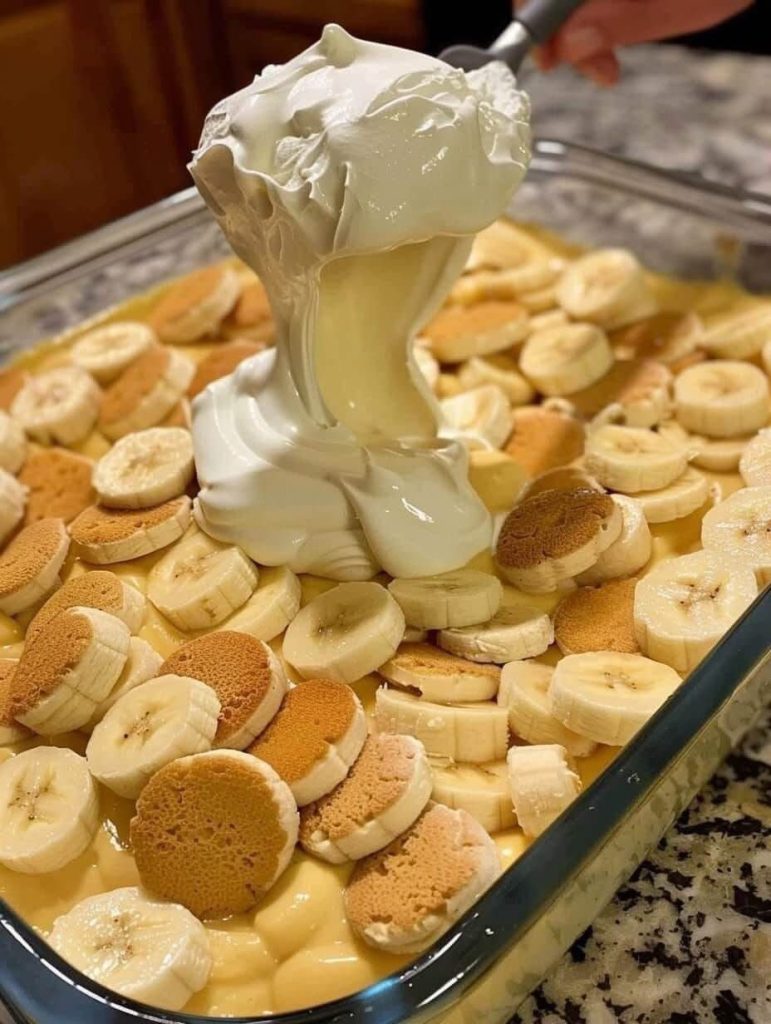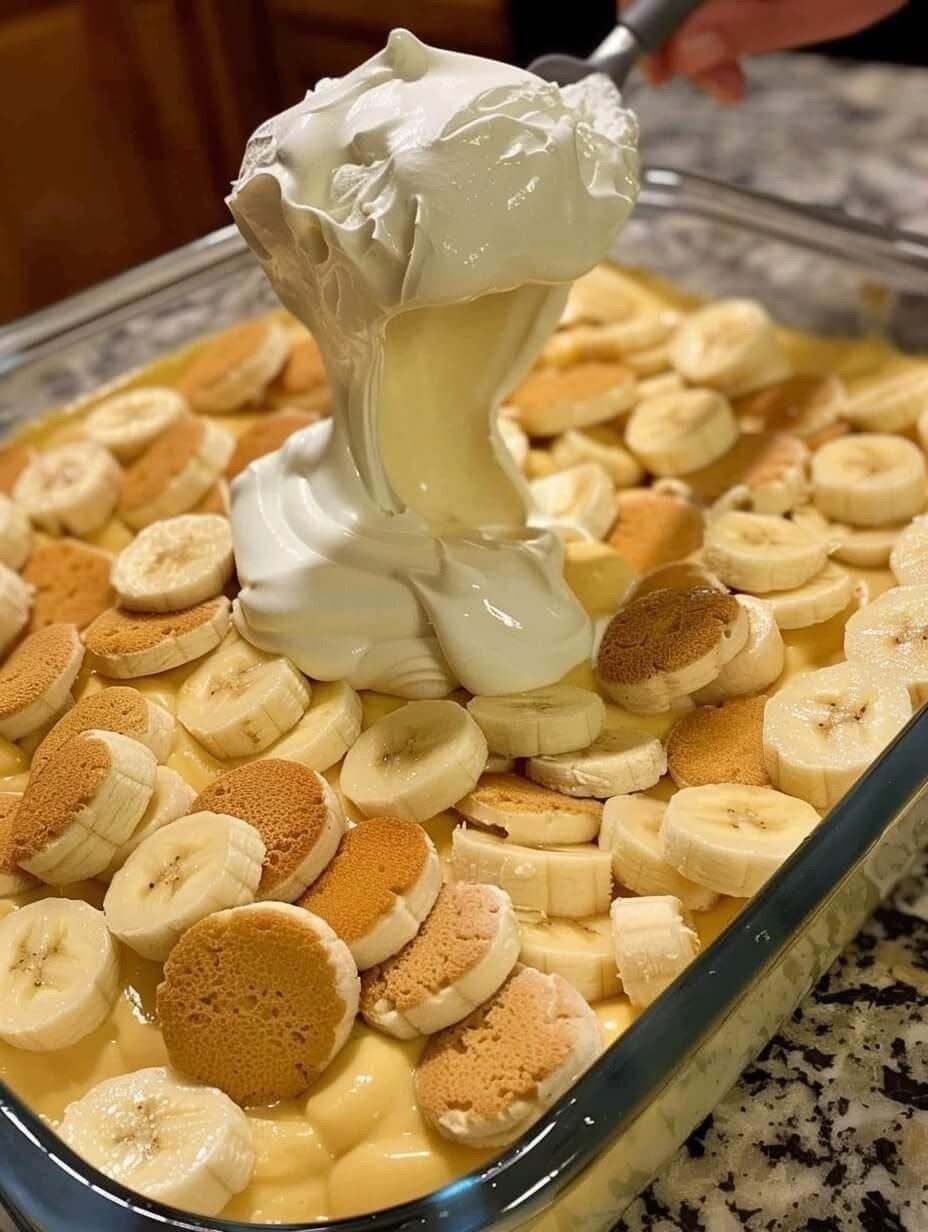
Recipe for Banana Pudding
Introduction: Banana pudding is a beloved dessert that’s both comforting and nostalgic, often associated with Southern cuisine. With layers of creamy vanilla custard, sliced ripe bananas, and crunchy vanilla wafers, it’s a dessert that has stood the test of time. Whether it’s served at family gatherings, potlucks, or enjoyed at home as a treat, banana pudding is a simple yet indulgent dessert that brings smiles to all who taste it.
History: Banana pudding dates back to the late 19th century and has become a classic American dessert, particularly popular in the South. The dish evolved from traditional custard recipes, which combined milk, eggs, and sugar to make a creamy base. The addition of bananas and the ever-popular vanilla wafers added a unique twist, creating a dessert that is both satisfying and easy to make. Over the years, many variations have emerged, but the core components have remained the same—rich custard, fresh bananas, and a crunchy texture from cookies.
Ingredients:
- For the custard:
- 1 cup granulated sugar
- 1/3 cup all-purpose flour
- 1/4 teaspoon salt
- 4 large egg yolks
- 2 3/4 cups whole milk
- 2 teaspoons pure vanilla extract
- 2 tablespoons unsalted butter
- For assembling:
- 6 ripe bananas, sliced
- 1 box of vanilla wafers (about 11 ounces)
- Optional:
- Whipped cream or meringue for topping
Instructions:
- Make the Custard:
- In a medium saucepan, whisk together the sugar, flour, and salt.
- In a separate bowl, whisk the egg yolks until smooth.
- Gradually add the milk to the dry mixture while whisking constantly to prevent lumps.
- Place the saucepan over medium heat, stirring continuously until the mixture thickens and comes to a gentle boil (about 8-10 minutes). Be sure to stir constantly to avoid scorching the custard.
- Once thickened, remove from heat and stir in the vanilla extract and butter until melted and smooth.
- Set the custard aside to cool slightly.
- Assemble the Pudding:
- In a large serving dish, begin by layering vanilla wafers on the bottom.
- Add a layer of banana slices over the wafers.
- Pour a generous amount of custard over the bananas and wafers, spreading evenly.
- Repeat the layers, ending with a layer of custard on top.
- Chill and Serve:
- Refrigerate the pudding for at least 4 hours (or overnight for best results) to allow the flavors to meld together.
- Before serving, optionally top with whipped cream or meringue for extra indulgence.
Methods:
- Traditional Method: The classic method of banana pudding involves homemade custard, but there are shortcuts available using instant pudding mixes for those in a rush. However, the rich texture and flavor of the homemade custard elevate the pudding.
- Vegan/Healthy Method: For a healthier version, you can use dairy-free milk, such as almond or oat milk, and a plant-based custard mix or cornstarch for thickening. Opt for organic vanilla wafers and fresh fruit for a cleaner, lighter version.
Benefits:
- Rich in Potassium: Bananas, a key ingredient, are rich in potassium, which is vital for maintaining heart health and regulating blood pressure.
- Good Source of Vitamins: Bananas also provide essential vitamins like vitamin C, which boosts the immune system.
- Protein from Eggs: The egg yolks in the custard provide protein and healthy fats.
- Calcium: The milk and butter contribute calcium for bone health.
- Low-Cost and Easy to Make: Banana pudding is relatively inexpensive and easy to make, making it a great option for large gatherings or family dinners.
- Rich in Potassium:
- Bananas are known for being high in potassium, a mineral essential for heart health. Potassium helps regulate blood pressure, reduces the risk of stroke, and maintains proper muscle and nerve function. Each serving of banana pudding provides a healthy dose of this vital nutrient.
- Supports Digestive Health:
- Bananas are a good source of dietary fiber, particularly pectin, which aids in digestion. The fiber helps promote regular bowel movements, reduces bloating, and supports a healthy gut. The pudding, made with fresh bananas, helps keep your digestive system running smoothly.
- Boosts Immune System:
- The vitamin C content in bananas helps boost the immune system by fighting off infections and promoting the production of white blood cells. Vitamin C also has antioxidant properties, which help reduce inflammation and protect the body from free radical damage.
- Provides Protein for Muscle Health:
- The eggs used in the custard provide protein and essential amino acids, which are important for muscle repair and growth. Protein is also crucial for maintaining a healthy metabolism and supporting skin, hair, and nail health.
- Bone Health:
- Milk and butter in the custard offer calcium, which is essential for bone health. Calcium helps maintain bone density, preventing osteoporosis and supporting teeth and joint health.
- Energy Boosting:
- The carbohydrates in the vanilla wafers, bananas, and milk give a quick source of energy. This makes banana pudding a satisfying dessert that not only tastes good but also provides a little boost in energy after a meal.
- Mood-Boosting:
- Bananas contain tryptophan, an amino acid that the body converts into serotonin. Serotonin is known as the “feel-good” neurotransmitter, which can help reduce stress, improve mood, and promote feelings of happiness and relaxation.
- Good for Skin:
- The vitamins and minerals in banana pudding, especially vitamin C and the healthy fats from eggs and butter, help maintain healthy skin. Vitamin C promotes collagen production, which is vital for skin elasticity and reducing wrinkles.
- Comforting and Satisfying:
- Beyond its nutritional benefits, banana pudding is a comfort food that brings joy and satisfaction. The combination of flavors and textures can be mentally soothing, making it a perfect treat for relaxation after a long day.
- Affordable and Accessible:
- Banana pudding is a relatively inexpensive dessert, using common ingredients that are easily accessible. This makes it a great choice for feeding a crowd or enjoying as a special treat without breaking the bank.
Nutritional Information (per serving):
- Calories: 350-400
- Protein: 6g
- Fat: 15g
- Carbohydrates: 50g
- Fiber: 2g
- Sugar: 30g
- Calcium: 150mg
- Potassium: 400mg
- Calories: 350-400 kcal
- Protein: 6g
- Fat: 15g
- Saturated Fat: 6g
- Carbohydrates: 50g
- Fiber: 2g
- Sugar: 30g
- Cholesterol: 60mg
- Sodium: 150mg
- Calcium: 150mg
- Potassium: 400mg
- Vitamin A: 8% of the Daily Value (DV)
- Vitamin C: 10% of the DV
- Iron: 6% of the DV
These values can vary based on the specific ingredients used, such as the type of milk, the amount of sugar, or whether whipped cream or meringue is added on top. However, this gives a general idea of the nutritional breakdown per serving of homemade banana pudding.
Formation: Banana pudding is best served in a large glass or ceramic bowl to show off its beautiful layers. Some people even serve it in individual cups for a fun presentation. The pudding should be stored in the refrigerator to maintain its creamy texture and prevent the bananas from browning too quickly. It’s essential to give the dessert time to set, as this enhances the flavor and allows the wafers to soften and absorb the custard.
Lovers of Banana Pudding:
- Families: Banana pudding is a family-friendly dessert that is loved by both kids and adults. It’s a go-to treat for family gatherings and holiday meals.
- Southern Cuisine Lovers: If you enjoy Southern comfort food, this dessert is a must-try. It’s often a staple at Southern potlucks and BBQs.
- Banana Enthusiasts: If you’re a fan of bananas, this is the perfect way to incorporate them into your dessert routine.
Conclusion: Banana pudding is a delicious, timeless dessert that satisfies all kinds of sweet cravings. Its creamy custard, sweet bananas, and crunchy wafers create a balanced texture and flavor that makes it irresistible. Whether you’re preparing it for a family dinner, a special occasion, or just because, banana pudding will bring joy and nostalgia to any meal. Give it a try, and soon you’ll understand why this dessert remains a favorite across generations.
